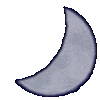

Issue #4 Date: 13/8/2001 In this issue: Editor's Note Slavic Sorcery Part 2 Ritual Space Animal Magick: Raven and Horse Crystals by Apasi and Sarah Written in the Stars: Monthly Horoscopes Tzu Wei Astrology Reiki: The History of Reiki Gods and Goddesses of Witchcraft: Danu Isis Book of Shadows Witchy Craft Ideas: Earth, Air, Fire and Water Bottles And Pentagram Dream Catchers Submit Your Own Work Previous Issues  |
Danu © Silversweet  The goddess Danu can be found under many names from Dana, Anu to her Welsh equivalent Don. She is the ancient Irish mother- goddess and was considered to be the goddess of rivers, wells, magic, prosperity, fertility (her totem animal being the mare) and wisdom as well as being a moon goddess. However she was also, being part of the Morrigan, a goddess of strife and war and, as many Celtic gods and goddess, she was a balance between ‘good’ and ‘evil’. The three war goddesses’ known as the Morrigan was comprised collectively of Danu alongside with Madb and Macha. These goddesses were known as the goddesses of death as well as life and symbolised life reborn, as the Celtic people of Ireland understood the importance of death in relation to life. Therefore they were the goddesses of destruction and creation. Danu was the maiden aspect of the Morrigan while Madb was the mother aspect and Macha was the crone aspect. The maiden aspect was associated with the colour white while the mother was associated with red and the crone was associated with black. Danu’s lineage seems to have come into some confusion as some evidence states that the Dagda, ‘the Good’ was her father while other sources claim him to be her son. In the sources where the Dagda is the son, the parents are claimed to be Danu and Bile (Belanus) who was a sun god. Danu, being the ‘mother goddess’ is not only the Mother Nature figure of Ireland but she also considered to be the mother of most of the gods and goddesses in the Celtic pantheon as well as the Tuatha De Danaan who are also known as the Sidhe or the ‘fairy folk’ or Ireland. Tuatha De Danaan meant literally ‘children of the goddess Danu’. The Dagda is also sometimes referred to as one of the people of Danu. The Tuatha De Danaan were said to be a race of mystical people who invaded Ireland long before the Milesians or Celts did. Damu was said to have guided them there but when the Celts came they retreated to the fairy hills, as some people say, or to the Otherworld from where they visited to physical world frequently. Others say that they became invisible but could make themselves appear human in front of the Celtic people. While the Celtic people followed the goddess Danu and believed in the Sidhe they would interact with them but when Christianity moved people away from the old ways the Tuatha de Danaan retreated into the hollow hills or ‘fairy mounds’ that can be found throughout Ireland. Descended from a goddess they were seen to be a race of Gods and were immortal themselves. Other children of Danu’s that have been named are Dian Cecht, Ogma (the god of writing and eloquence) and Lir while other names such as Goibhniu, the god of metalwork and Nuadhu Airgedlámh, the ancestral king have also been associated. They only had one son between them who was Ecne meaning knowledge. Danu’s day of celebration in Celtic tradition was on May the 1st, which was known as Beltane in the old calendar. At this time the land was ripe and fertile and as the land represented the goddess this was showing Danu’s fertility aspect and the God, most likely referring to Danu’s husband Bile, showing his love for the goddess Danu. Silversweet  E-mail Silversweet at: silversweetgirl@hotmail.com Disclaimer: All the information included in this article has been reproduced from the following sites. The author and this magazine own none of the information and take no legal responsibility for its reproduction or use. Sources: http://www.crosswinds.net/~daire/names/deities.html http://web.raex.com/~obsidian/CeltPan.html http://www.pantheon.org/areas/mythology/europe/celtic/articles.html http://www.cybercomm.net/~grandpa/celtic.html http://nikki.sitenation.com/celtic/danu.html http://members.tripod.com/ClanOfDanu/1.html http://www.witchs-brew.com/shadows/goddess/danu.html http://home.ici.net/~ariadne/danu.html http://www.britannia.com/celtic/gods/don.html http://www.lunaea.com/goddess/power/danu.html http://www.ckaren.com/fae/dana.html http://www.cybercomm.net/~grandpa/triple.html http://www.shadowdrake.com/welshirish/dondana.html |




